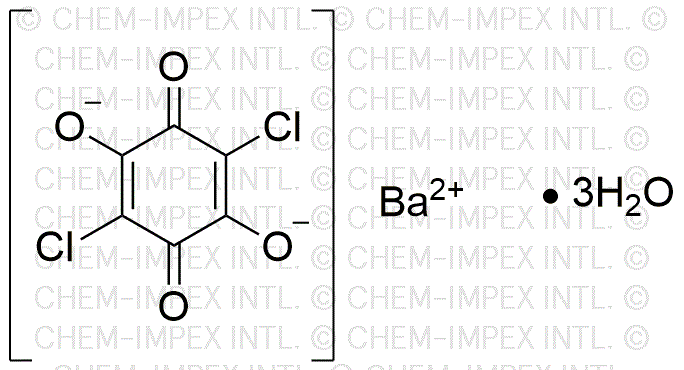Barium chloranilate trihydrate is widely utilized in research focused on:
- Analytical Chemistry: This compound serves as a reagent in various analytical methods, particularly in the detection and quantification of certain metal ions. Its ability to form stable complexes enhances the accuracy of analytical results.
- Colorimetric Analysis: It is used in colorimetric assays, where it reacts to produce distinct color changes, allowing for easy visual assessment of concentrations in solutions. This application is particularly beneficial in environmental monitoring.
- Material Science: Barium chloranilate trihydrate is employed in the synthesis of advanced materials, such as polymers and composites, due to its unique chemical properties. This can lead to the development of materials with enhanced durability and performance.
- Pharmaceutical Research: In the pharmaceutical industry, it is explored for its potential applications in drug formulation and delivery systems, leveraging its stability and solubility characteristics to improve bioavailability.
- Educational Purposes: This compound is often used in educational settings for laboratory demonstrations and experiments, helping students understand complex chemical reactions and analytical techniques in a hands-on manner.
General Information
Properties
Safety and Regulations
Applications
Barium chloranilate trihydrate is widely utilized in research focused on:
- Analytical Chemistry: This compound serves as a reagent in various analytical methods, particularly in the detection and quantification of certain metal ions. Its ability to form stable complexes enhances the accuracy of analytical results.
- Colorimetric Analysis: It is used in colorimetric assays, where it reacts to produce distinct color changes, allowing for easy visual assessment of concentrations in solutions. This application is particularly beneficial in environmental monitoring.
- Material Science: Barium chloranilate trihydrate is employed in the synthesis of advanced materials, such as polymers and composites, due to its unique chemical properties. This can lead to the development of materials with enhanced durability and performance.
- Pharmaceutical Research: In the pharmaceutical industry, it is explored for its potential applications in drug formulation and delivery systems, leveraging its stability and solubility characteristics to improve bioavailability.
- Educational Purposes: This compound is often used in educational settings for laboratory demonstrations and experiments, helping students understand complex chemical reactions and analytical techniques in a hands-on manner.
Documents
Safety Data Sheets (SDS)
The SDS provides comprehensive safety information on handling, storage, and disposal of the product.
Product Specification (PS)
The PS provides a comprehensive breakdown of the product’s properties, including chemical composition, physical state, purity, and storage requirements. It also details acceptable quality ranges and the product's intended applications.
Certificates of Analysis (COA)
Search for Certificates of Analysis (COA) by entering the products Lot Number. Lot and Batch Numbers can be found on a product’s label following the words ‘Lot’ or ‘Batch’.
*Catalog Number
*Lot Number
Certificates Of Origin (COO)
This COO confirms the country where the product was manufactured, and also details the materials and components used in it and whether it is derived from natural, synthetic, or other specific sources. This certificate may be required for customs, trade, and regulatory compliance.
*Catalog Number
*Lot Number
Safety Data Sheets (SDS)
The SDS provides comprehensive safety information on handling, storage, and disposal of the product.
DownloadProduct Specification (PS)
The PS provides a comprehensive breakdown of the product’s properties, including chemical composition, physical state, purity, and storage requirements. It also details acceptable quality ranges and the product's intended applications.
DownloadCertificates of Analysis (COA)
Search for Certificates of Analysis (COA) by entering the products Lot Number. Lot and Batch Numbers can be found on a product’s label following the words ‘Lot’ or ‘Batch’.
*Catalog Number
*Lot Number
Certificates Of Origin (COO)
This COO confirms the country where the product was manufactured, and also details the materials and components used in it and whether it is derived from natural, synthetic, or other specific sources. This certificate may be required for customs, trade, and regulatory compliance.


